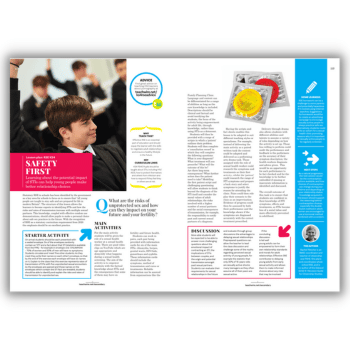Behaviour in boys – 5 misconceptions that teachers must overcome

Sam Strickland highlights five stubborn fallacies that teachers still labour under when addressing school behaviour issues among boys

‘Your worst enemy is your best teacher’
– Buddha
Every summer, under ordinary circumstances, school exam results are published. And every summer, many headteachers and senior teams will scratch their heads at the outcomes of boys in education.
For this, we can thank a persistent attainment and progress gap between the performance of boys versus girls, especially at GCSE, which sees girls tending to outstrip their male counterparts. I’ve worked in schools where boys’ performance and the behaviour of boys becomes the focus.
In response, a myriad silver bullets are cited as the Holy Grail that will unlock the Pandora’s Box that is boys. There’s often a feeling that if only the behaviour of boys could be fixed in KS3, where the underlying historic issues surely lurk, then KS4 will fix itself.
Five fallacies
Sadly, there are endless misconceptions surrounding boys and how they should be handled, dealt with and encouraged to behave. Some of the key and common misconceptions that I regularly see include:
1: Boys should be treated differently
This is a dangerous misconception, and as misplaced as stating that Pupil Premium pupils should be questioned first in lessons, or have their books marked first. If we treat boys differently, many unintended consequences will manifest as a result.
2: Boys respond to competition
This may be true of some boys, in the same way that it may be true of some pupils. However, not all boys like competition. If you make everything a competition to inspire boys to behave better and achieve more, then you should be extremely mindful of those boys who lack confidence and self-esteem, and have an inbuilt fear of failure. Competition can simply serve as a vehicle to reinforce a sense of imposter syndrome in young boys.
3: Use sporting references to engage boys
For every boy that enjoys sport and loves a good sporting analogy, there will be one that doesn’t. Adopting this sort of approach is likely to be divisive and put boys off from engaging with you.
Educationally, this is also serves to restrict the cultural diet they’re exposed to, and should therefore only be used sparingly and with caution.
4: Try to be their friend
I’ve seen this approach used first-hand, whereby teachers will try to get to know key pupils and befriend them, in order to better understand how they think or how they ‘tick’. There’s a huge danger when you try to befriend pupils, in that the line between teacher and pupil can become blurred and confused, ultimately doing more harm than good.
I would not, however, dispute the value of developing professional teacher-pupil relationships that are built on a trust in you and your professionalism to serve as the teacher.
5: Pace carefully and utilise different learning styles
These approaches have been largely debunked in recent years, with plenty of evidence to suggest that both actually work to shy pupils, especially boys, away from learning. We need to remember that learning is hard, that learning is not linear and that the content should be the engager.
Forward planning
If we are to truly engage boys – as per any sub group of pupils in our classes – then we must carefully consider the interplay between the holistic whole-class approaches that we employ, and the bespoke, personalised support that we offer our pupils.
When any teacher assumes a new class, it’s critically important that they plan out the routines for learning that they want to employ. This actually needs as much time and thought as your subject knowledge. You should give careful consideration as to how you want pupils to enter your classroom, how you want them to transition from one aspect of your lesson to the next, how you want lesson resources to be distributed, the entry and exit routines you employ, when you want your class to be silent and when you want them to talk.
Routines, once they’ve become habitual, will allow you and your pupils to think more freely, enable lessons to be more creative and imaginative, and give you greater confidence as a teacher to take more risks.
Clear expectations
Underpinning these considerations should be a clear set of expectations for your class to live up to. I would argue that you should employ no more than three expectations, while ensuring that these are highly visible and on display. Equally, think about how those expectations link to the school’s values, and how they can be used as a script when correcting pupil behaviour. This will add a layer of consistency to your interactions with pupils.
All pupils need to be presented with clear routines, expectations and norms so that they know where they stand, what’s expected of them and how they can and should behave. This will serve to change the social norm in your class.
Most pupils are ultimately conformists, and this is especially true of teenagers. If you can succeed in positively changing the social norm, then you’ll likely find that boys – and indeed all pupils – consequently raise their game.
Earned success
It’s also vitally important that you make success achievable, while ensuring that this success isn’t cheapened. Boys, girls, all pupils, need to know that they can achieve and that they can succeed, which will in turn support their self-esteem and self-belief.
You can build this by purposefully employing carefully crafted retrieval activities into lessons to build pupil confidence. Direct instruction techniques, modelling and scaffolding are also key.
It’s important that you continuously check for understanding by paying specific attention to your questioning techniques – not only to ensure that all pupils understand, but also that they know the key disciplinary knowledge that you want them to have learnt. You can then celebrate, by employing the use of proportionate praise to reaffirm the successes of your pupils.
Boys, as with all pupils, respond best to teachers who have lessons that are well structured, who are consistent in their approach to behaviour, and who support their pupils to learn. They will also respond well to teachers who care and seek to build positive relationships. Pupils won’t respond to tricks, nor gimmicks – at least not for any length of time.
Whilst we shouldn’t dismiss the relevancy of peer pressure, the influence of social media and the need to conform, we also shouldn’t lose sight of what makes for effective teaching. If that happens, then we do our pupils a disservice.
Sam Strickland (@Strickomaster) is the principal of a large all-through school, having previously been a head of history, assistant headteacher and associate principal
For more strategies and approaches to support positive behaviour and pupil learning, read Sam’s new book, The Behaviour Manual – An Educator’s Guidebook (£15, John Catt Educational)












